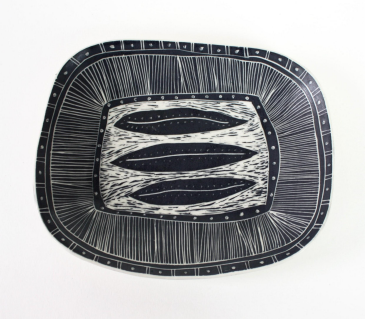Sgraffito in Black and White
By Jean Cunningham
Sgraffito—pronounced skrah-fee-toh—is the art of applying layers of plaster, paint, or glaze to a surface and then scratching to show the colors of the surface underneath. Sgraffito is an age-old art technique used in Chinese ceramics as early as AD 600-900 and by Islamic potters as early as AD 1050. It was popularized in the western world on building facades by Italy in the 15th and 16th centuries.
Andryea Natkin uses the sgraffito technique when creating functional art out of clay and ceramics. Plates, bowls, dishes, vases, candleholders, swizzle sticks, and more emerge from her studio. Hers is a small batch process making just a few items at a time. Most items are black and white, and every item is unique. The skills she uses include manipulating the clay, applying glazes, painting, and applying sgraffito designs with scratching tools.
Natkin’s home studio is in a 10 x 10 bedroom she coopted when her daughter moved out. They self-built the home in the 80s during the energy crisis, and it incorporates solar heating, including a south facing greenhouse that is a passive solar collection buffer. It is here that her small electricity powered kiln is located. The greenhouse is perfect for airflow and access.
The studio is filled with the tools and inspiration to create art. Functionally, there is a manual slab roller, paint brushes, a wide variety of tools used to scratch the surfaces, and rolls of plastic to cover the unfinished pieces while they “rest” and partially dry. There are images of prior work, pages of design sketches, and mosaics produced in the past for inspiration.
Natkin’s creative process converts 25 lb. bags of clay into finished pieces. She starts by using a wire to slice a 1-1 ½ inch thick section off a clay block. This she runs through her slab roller—a process very similar to using a pasta roller—reducing the gap between the rollers on each pass to get to the desired thickness. She then lets the piece rest a bit to stiffen up enough so that it does not distort as she works with it. This is just the first of many rest periods in her process.
Next, she either cuts the clay using a flat pattern, or she drapes the clay over a form such as a bowl or other found item to begin creating the shape. Cutting to size is done with an X-ACTO or other sharp knife. If the piece has edges that must be sealed together (e.g. a mug), she scores or roughs up those edges and uses some slip, which is watered down clay, to “glue” the edges together.
If the item should have a handle, she pinches off some clay and rolls it in her hands to fashion the desired shape, and then attaches it to the main piece. The piece now has its final shape, and she lets it rest to further dry. When Natkin cannot get back to the piece in a timely manner, she will put it in her ceramicist’s damp box. It is a box with a solid slab of damp plaster in the bottom where unfinished clay pieces can be placed. When sealed, the box will keep the pieces moist for weeks.
Natkin’s experience enables her to know when the piece is near the necessary dryness. At this point the clock starts ticking and she must know exactly when the piece is neither too hard nor too wet for applying glaze. When the piece is right, she adds an underglaze. The underglaze is usually black. She will brush it on either the inside or the outside of the item. On the side with the underglaze, she creates a design by using her scraping tools to scratch areas of underglaze off to reveal the white clay underneath. On the unglazed side, she will often inscribe marks into the white clay. On a bowl for example, she may have the black underglaze on the inside with a sgraffito design and some surprise marks on the outside that will be white.
She lets this piece dry until bone dry. If it is too cool, it is still wet. It must be as warm as her cheek, and then it is ready to go into the kiln for a bisque fire. This will make the piece even stronger so that she can continue to embellish the item.
Based on different design decisions, she may wipe underglaze over the white side where she had inscribed surprise marks. This pushes black underglaze into the marks, but she immediately wipes off any excess. This leads to Natkin’s distinctive style of white on black on one side, and black on white on the other. In other cases, she may add some minimal color work for the design. Once the design is complete, she adds a coat of food-safe, clear glaze which seals the clay. Finally, she fires it in the kiln for the last time.
For marketing purposes, each piece is photographed multiple times in different angles, put into an inventory sheet, and listed on her website and other social media. She finds the more organized she can be with these steps, the less time she must spend on administration and order fulfillment later.
If you would like to learn more about Andryea Natkin’s ceramics, visit her website at andryeanatkin.com, or on Instagram @andryeanatkin.
Shop Andryea's distinctive functional clay artwork on ShopEvanstonMade.org
Jean Cunningham is retired after a career in business management and finance. She has written three books and authored many articles in her field, was a speaker at conferences, and taught at the university level. While traveling for business she began painting and drawing for relaxation and collecting art. She and her husband have lived in Evanston for 11 years and are avid walkers of the town and lakeside. She has a BS from Indiana University and an MBA from Northeastern University.






